 |
|||
|
|
|||
|
Page Title:
Figure 406-2. Low-Altitude Approach Examples. |
|
||
| ||||||||||
|
|  JOINT ADVANCED MULTI-ENGINE T-44A
Procedure Turn - Holding Technique
Procedure Turn - Holding Technique
Procedure Turn
Teardrop Entry
Parallel Entry
45/180 Maneuver
Figure 406-2. Low-Altitude Approach Examples.
B. Types of Course Reversals. There are two common types of course reversals: the procedure turn
(PT) and the holding-in-lieu-of procedure turn (HILO PT). Before discussing each type of course reversal
in detail, here are some guidelines that apply to all course reversals:
Restrictions. Do not execute a procedure turn or HILO PT in the following situations. (Many people use
the memory aid SNERT)
When ATC gives you clearance for a "Straight-in" approach
If you are flying the approach via No PT routing
When you are Established in holding, subsequently cleared the approach, and the holding course and
procedure turn course are the same
When ATC provides Radar vectors to the final approach course
When ATC clears you for a Timed approach. Timed approaches are in progress when you are
established in a holding pattern and given a time to depart the FAF inbound
In any of the situations described above, proceed over the FAF at the published FAF altitude and continue
inbound on the final approach course without making a procedure turn, holding pattern, or any other
aligning maneuver before the FAF unless otherwise cleared by ATC. If you need to make additional
circuits in a published holding pattern to lose altitude or to become better established on course, or wish to
execute a procedure turn for training before departing the FAF inbound, it is your responsibility to request
such maneuvering from ATC.
NOTE: Historically, these restrictions create lots of confusion between pilots and controllers. If you are ever in
doubt about what ATC expects you to do, query the controller.
1.
Procedure Turns.
One of the most common types of low altitude course reversals is the procedure turn. Procedure turns are
depicted in the plan view of U.S. government charts with a barb symbol (
) indicating the direction or
side of the outbound course on which the procedure turn or maneuvering is to be accomplished. The
procedure turn fix is identified on the profile view of the approach at the point where the IAP begins. To
give you an idea of what the procedure turn airspace looks like, refer to figure 407-2.
Techniques for Flying Procedure Turns. There are two common techniques for executing a procedure turn
course reversal: the 45/180 degrees maneuver and the holding technique. For standardization purposes, the
45/180 degrees course reversal is the primary method of procedure turn used throughout the advanced
maritime syllabus; however, you must still be familiar with and prepared to fly procedure turns using the
other techniques. Regardless of the method you choose to fly the procedure turn, consider the following
notes when planning your approach:
Plan the outbound leg to allow enough time for configuration and any descent required prior to the
FAF. Ensure you adjust the outbound leg length so you will stay inside the "remain within
distance" noted on the profile view of the approach plate. The "remain within distance" is
measured from the procedure turn fix unless the IAP specifies otherwise.
Consider established inbound to be a course guidance indication of +5 radials for VOR or TAC
4-34
RADIO INSTRUMENTS STAGE
|
|
Privacy Statement - Press Release - Copyright Information. - Contact Us |